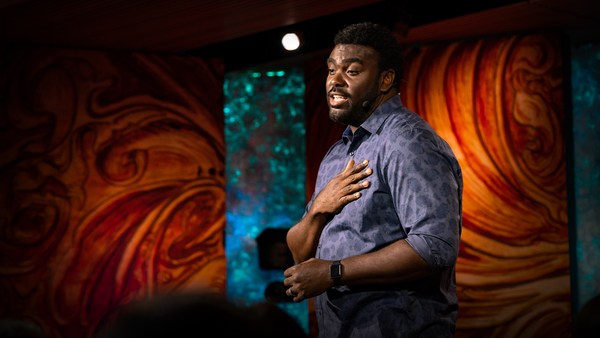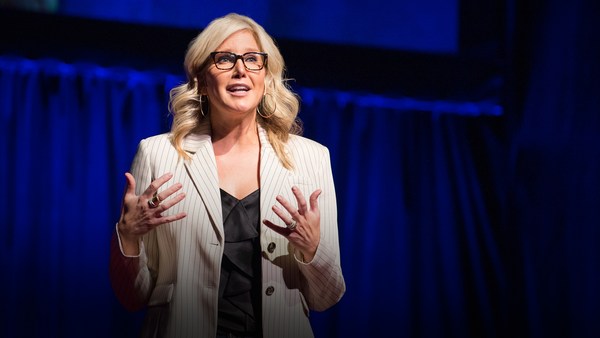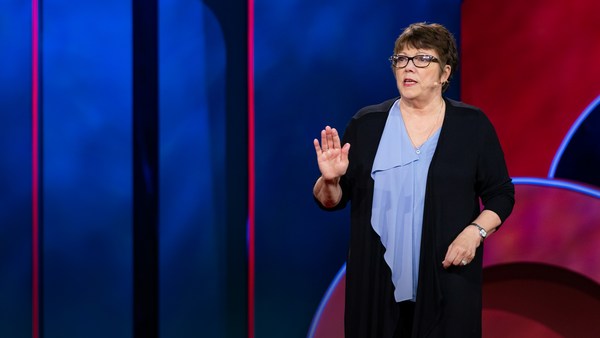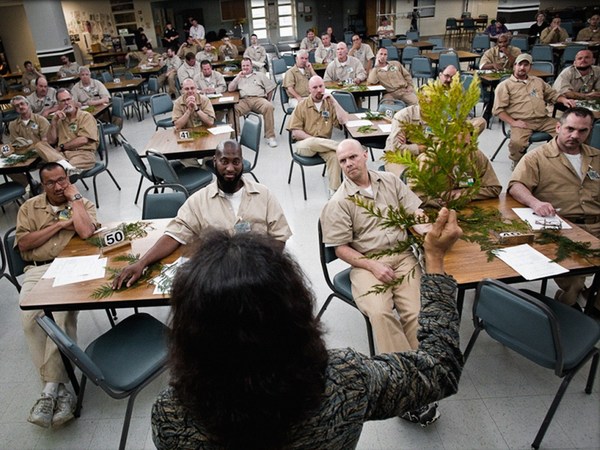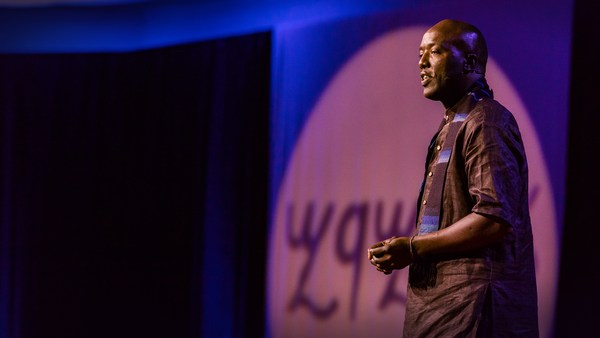The drive through the world's most secure prison is beautiful. The federal government's only supermax prison, known as ADX, is 90 miles south of Denver. Standing outside the building, ADX looks like a newish suburban middle school.
(Laughter)
The lobby is clean and bright; there's big windows and clear views of the mountains; and a polite front-desk attendant with a kiosk selling travel mugs.
(Laughter)
On the wall is a large plaque that reads, "The best prize that life offers is the chance to work hard at work worth doing." Just past it is a huge framed photo of Alcatraz. And down the stairs, at the end of a long hallway, are 400 men decaying in isolation cells.
I work on cases involving the constitutional rights of prisoners. Now, people have differing views about prisoners' rights. But there's something more people can agree on: torture. The US government says it doesn't use torture, and we condemn other countries, like Iran and North Korea, for their use of torture. But some people think the so-called worst of the worst deserve it: terrorists, mass murderers, the really "bad" people. Now I personally believe that no one deserves to be tortured by the US government. But that's me.
(Applause)
No matter where you fall, there's a few things I need you to understand before I continue. First, we do torture people here in America, tens of thousands of them every day. It's called solitary confinement. It's done in our names, using our tax dollars, behind closed doors. And as a result, we're undermining the core values of our justice system.
Built with state-of-the-art technology, ADX has nearly perfected solitary confinement. Each man spends 23 hours a day alone in a cell the size of a small bathroom. Virtually every aspect of his life occurs in that cell. But aside from sleeping and eating, which he does within an arm's reach of his toilet, there aren't many aspects of life. Correctional officers push food trays through slots in the doors and take the men to solitary exercise cages that are referred to by prisoners and staff alike, without irony, as dog runs. Other than that, these men are locked in cement closets, all day, every day. Two steps forward, two steps back. That's it. They can't see the nearby mountains or any trees -- "nothing living, not so much as a blade of grass," is how one man in ADX described it. Some people report that after years of not looking at anything further than 10 feet away, their eyesight has deteriorated so much that they can't focus on faraway objects anymore.
The isolation is so deep and profound that one of our clients would lie on the floor of his cell for hours, just hoping to catch a glimpse of someone's feet as they walked past the door of his cell. Another befriended a wasp that flew into his cell, feeding it and talking to it like a friend. Some try to communicate with fellow prisoners by yelling through the shower drains. Still though, many of these men lost their voices after talking with us for just an hour. Their vocal cords were out of practice speaking for that long.
We know the impact of long-term isolation is devastating. This borders on common sense. It's why harsh prison systems and torture regimes routinely use solitary as a form of severe punishment. And why none of us would tolerate having a loved one, like a parent or a child, locked alone in a small bathroom for days, let alone years. Or decades.
In the course of representing that first client at ADX, we learned about another man, Tommy Silverstein, who the Federal Bureau of Prisons put in solitary confinement under a "no human contact" order in 1983, after he killed a corrections officer. Tommy was 31 years old. Now he's 66. He's been in solitary confinement for 35 years. Struggling to find the words to capture his experience of ADX, Tommy, who has become an accomplished artist, drew it instead.
Unless we start to change how we treat prisoners in this country, he'll probably be there for the rest of his life.
Both John McCain and Nelson Mandela said that of all the horrors they suffered in prison, solitary confinement was the worst. That's because solitary puts people at risk of losing their grasp on who they are, of how and whether they're connected to a larger world. As psychologist Dr. Craig Haney explains, that's because human identity is socially created. We understand ourselves through our relationships with other people. Solitary confinement can make you change what you think about yourself. It can make you doubt whether you even have a self. Some people in solitary aren't even sure they exist, so they'll mouth off to a corrections officer and end up getting shackled or beaten. But at least then, they know they exist. Over time, some of the men in ADX break down in obvious ways, like banging their heads on the walls of their cells or smearing themselves with feces. Or attempting suicide, some of them successfully. Many people cut themselves just to feel the pain that keeps them tethered to the real world. Others adjust, showing no outward sign of mental illness.
But there's grave harm in the adjustment itself. That's because the experience of long-term isolation can paradoxically lead to social withdrawal. At first, people are starved for human contact, but over time, it becomes disorienting, even frightening. They can't handle it anymore. All of this amounts to a prolonged social death. The men in ADX are stuck in suspended animation. Not really part of this world, they're not really part of any world that's fully and tangibly human. It's for all of these reasons that international human rights law prohibits the use of long-term solitary confinement. In fact, the UN has called on governments to ban the use of solitary for more than 15 days. As of today, Tommy Silverstein has been in solitary for 12,815 days.
Now in judging other countries' human rights records, the US State Department has called the use of long-term solitary a human rights violation. In 2009, for example, State Department condemned Israel, Iran, Indonesia and Yemen for their use of solitary. But we allow it to happen on our own soil. When a prison is located in the US instead of China, when it's run by the federal government and not some rogue sheriff, when it has state-of-the-art technology and gleaming floors, not overcrowded cells and decrepit facilities, it's harder to believe that torture happens there. But it's important to entertain the idea that, sometimes, this too is what torture looks like.
As a civil rights lawyer, I believe it's important to ensure that people, even those convicted of terrible crimes, aren't tortured by our government. And if this talk were a movie, I'd tell you next about how we fought and fought and eventually won. But this isn't a movie. So I'll tell you, instead, about how deeply this injustice is hidden. How difficult it is to expose it, and why it's important that we do.
You'd think that lawyers, people who work in the justice system, would know what happens in our prisons. But I'm a lawyer, and I live less than two hours away from ADX. And until we went to see that first client, I didn't know anything about it. I don't think that's an accident. ADX walls itself off from public scrutiny. In the 25 years since it opened, it's allowed only a single visit by human rights organizations. Journalists are routinely denied entry. Mail is censored. And even when rare family visits occur, they're monitored by an unseen government official who can cut the visit off without notice if he thinks that the prisoner is talking in too much detail about the conditions in ADX.
In China, in Russia, they keep out the human rights observers, keep out the media, keep out the UN. And so do we. ADX is, in the words of one journalist, "a black site on American soil."
We know that secrecy is a hallmark of places that torture. But after years of shining a light, we now know more about the conditions in Guantanamo than we do at ADX. Five years ago, when there was a hunger strike and force-feeding at Guantanamo, the same thing was happening at ADX. But you probably didn't hear about it because the government gagged family members and lawyers from talking about it.
But here's the thing: the American criminal justice system is supposed to be transparent. And before someone gets sent to prison, that's largely true. Legislators meet in public to debate and define the laws that prohibit criminal conduct. Citizens in our community serve as jurors on criminal trials. And if you want to watch a trial, the courtroom doors are wide open. After the trial, though, our commitment to transparency ends. With the prison door securely shut, what happens behind prison walls stays behind prison walls. And without the scrutiny of the public gaze, the darkness festers.
Other than execution, incarceration is the most intrusive power of the state: the deprivation of citizens' liberty. But no government institution is more opaque and less accountable than prison. Even though prisons are supported by tax payers and return 95 percent of their residents to our communities. It's that secrecy that allows the ADX to disappear people.
And so we have an obligation, said Justice Kennedy, as a democracy and as a people, "we should know what happens after the prisoner is taken away." The prison system is the concern and responsibility of every citizen. This is your justice system. These are your prisons. Torture happens in the dark. And so we need to embrace the admonition that sunlight is the best disinfectant. Not only because we need to know what happens inside ADX, but because the knowing itself can create change.
There's an axiom in physics called the uncertainty principle. It teaches that the mere fact of observation can alter, will alter, the subatomic reaction being observed. In other words, watching something affects its course. In a democracy like the US, prisons are administered in our name and on our behalf. The conditions in ADX implicate our tax dollars, public safety and, most of all, our shared belief in the inherent dignity of every human being. We have an obligation to bear witness.
Thank you.
(Applause)
